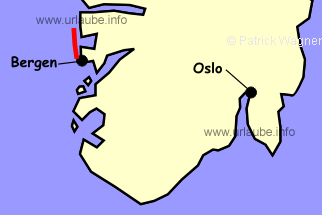|
|
|
Hurtigruten Day 1: Departure in Bergen
Although the Hurtigruten is supposed to be the center of these pages, we don't want to consider Bergen – with its 231.000 inhabitants the second biggest city of the country – only as a departure and endpoint of this boat trip. As Bergen is a special city – at least, the people of Bergen believe that – and I tempt to join to this opinion. Only the rain makes Bergen to be something special, as here, it rains three times more as it does in Hamburg or Munich. 
Of course, tourists are horrified by such prospects. But when the sun shines, a kind of mediterranean way of life awakes in the people. Then, the sun lovers meet outside in coffee bars and restaurants , of which there is no deficit in Bergen. The tourists should take an example of the local people to leave the historical buildings, museums or galeries apart and walk instead through the old districts, the hanseatic district Bryggen or the fish market and enjoy the view to the city from the local mountain Floyen; Everything else can be done when it is not raining! Bergen, established in the year 1070 one of the oldest cities of Norway. In the 12th and the 13th century, Bergen was the capital of the country. 
The base of the wealth and prestige of the city was the trade with fish products. Here in Bergen, there was an abundance of dried fish, one of the most important products of the medieval times that was brought by the inhabitants of the northern country into the city and were then shipped from Bergen. Bit by bit, the hanseatic people took the trade over, until then, by mid of the 16th century, the decadence of the Hanseatic people began. The Norwegian merchants took the trade on their own hands, and the entrepreneurial craftsmen and business men from Holland, Germany, England and Scottland settled down in Bergen. A new high period began, an epoch that generated in the cultural area Ludwig Holberg, the first and most important nordic comedy poet. The economic boom of the city also lasted in the 19th and 20th century. The shipping traffic and the trade provided the city capital and numerous companies were established. Also the intellectual life got more important; World famous artists matured here: J.C Dahl created the modern Norwegian painting. Ole Bull conquered the world with his violin. But the biggest pride of Bergen is Edward Grieg, who knew how to express the character of Norway and its people through his dateless music. Every year during the first half of June, he is honored by the international music festival. Beside the traditional trade and shipping, today, the economy of the city is dominated by the industry, the construction sector, administration and service sector, not least the oil findings in front of the coast. But back to Hurtigruten, the real reason for our stay in Bergen. One increasingly looks exitedly forward to the journey and the first contact with the fast boat. Those who arrive early or the day before probably feel like having a little walk to the outer tip of the peninsula Nordnes in order to watch from there the return of the Hurtigruten ship and record it on video, film, or memory card. 



Just under half an hour from the fish market, there is a park in which one can find an ideal place for a little picknick, provided the weather is nice. If the weather is bad, one can do an excursion and visit the sea aquarium with the biggest collection of salt water fishes and lower sea animals of Europe; Around 13.15 p.m., one should pay special attention to the north. The scheduled arrival time is indeed 14.00 p.m., but it already happened that the fast steamer kives up to its name and ends its long journey before that time. Then the ship appears as a little dot in the north, gets closer and passes Nordenes in front of the huge Asköy bridge. After that, one can watch the landing maneuver of the Hurtigrute form a distance. 


But now there is to wait until 05.00 p.m., (in the winter time 06.00 p.m.), as then one can finally get on board of the Hurtigrute. The cabin is shortly checked, the suitcases unpacked but the homely setup is postponed to a later point of time. What is now more important is the exploration of the ship and the clarifiction of which table we use during the meals. As a start of the journey, a "little snack" is served in the evening as a cold buffet; No one should start the journey being hungry. Then the multilingual greeting follows per loudspeaker: "Ladies and gentlemen, good evening and welcome on board. The steamship is ready for start. The tour guides and the crew wish you a nice journey." 
Then the command is set off: "Cast off"! The ship starts to vibrate, loosens carefully of the dock and slowly starts to navigate. The " amphitheatre" of the city, formed by 7 mountains, is slowly left at the stern of the ship behind. The journey alongside the terrific Norwegian coast has begun. 
Back to the index Norway-Hurtigruten Author: Manfred Hofmann; Copyright: Patrick Wagner, www.tourist-guide.biz |
||



